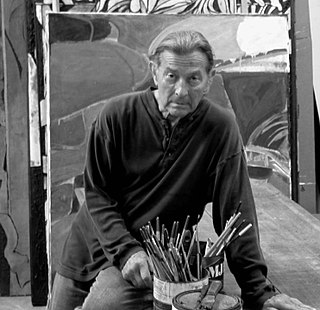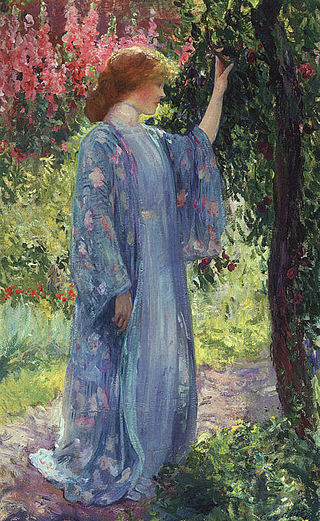Related Research Articles

En plein air, or plein-air painting, is the act of painting outdoors.

The Hammer Museum, which is affiliated with the University of California, Los Angeles, is an art museum and cultural center known for its artist-centric and progressive array of exhibitions and public programs. Founded in 1990 by the entrepreneur-industrialist Armand Hammer to house his personal art collection, the museum has since expanded its scope to become "the hippest and most culturally relevant institution in town." Particularly important among the museum's critically acclaimed exhibitions are presentations of both historically overlooked and emerging contemporary artists. The Hammer Museum also hosts over 300 programs throughout the year, from lectures, symposia, and readings to concerts and film screenings. As of February 2014, the museum's collections, exhibitions, and programs are completely free to all visitors.

Catherine Sue Opie is an American fine-art photographer and educator. She lives and works in Los Angeles, as a professor of photography at University of California at Los Angeles.

The J. Paul Getty Museum, commonly referred to as the Getty, is an art museum in Los Angeles, California housed on two campuses: the Getty Center and Getty Villa.

James Jarvaise was an American painter based in Southern California.

The terms California Impressionism and California Plein-Air Painting describe the large movement of 20th century California artists who worked out of doors, directly from nature in California, United States. Their work became popular in the San Francisco Bay Area and Southern California in the first three decades after the turn of the 20th century. Considered to be a regional variation on American Impressionism, the California Impressionists are a subset of the California Plein-Air School.

Decorative Impressionism is an art historical term that is credited to the art writer Christian Brinton, who first used it in 1911. Brinton titled an article on the American expatriate painter Frederick Carl Frieseke, one of the members of the famous Giverny Colony of American Impressionists, "The Decorative Impressionist."

The Musée d'art moderne André Malraux is a museum in Le Havre, France containing one of the nation's most extensive collections of impressionist paintings. It was designed by Atelier LWD, an architecture studio led by Guy Lagneau, Michel Weill and Jean Dimitrijevic. It is named after André Malraux, Minister of Culture when the museum was opened in 1961.

The Magpie is an oil-on-canvas landscape painting by the French Impressionist Claude Monet, created during the winter of 1868–1869 near the commune of Étretat in Normandy. Monet's patron, Louis Joachim Gaudibert, helped arrange a house in Étretat for Monet's girlfriend Camille Doncieux and their newborn son, allowing Monet to paint in relative comfort, surrounded by his family.

Jules-Antoine Castagnary was a French liberal politician, journalist and progressive and influential art critic, who embraced the new term "Impressionist" in his positive and perceptive review of the first Impressionist show, in Le Siècle, 29 April 1874.

Mary Evelyn McCormick was an American Impressionist who lived and worked around San Francisco and Monterey, California at the turn of the 20th century.
Joachim Pissarro is an art historian, theoretician, curator, educator, and director of the Hunter College Galleries and Bershad Professor of Art History at Hunter College of the City University of New York. Since 2002, Pissarro has served as the Editorial Director of Wildenstein Publications. His latest book, authored with art critic David Carrier, is called Wild Art. Pissarro was curator at the Museum of Modern Art's Department of Painting and Sculpture from 2003 to 2007.

Ree Morton was an American visual artist who was closely associated with the postminimalist and feminist art movements of the 1970s.
Charlotte Cotton is a curator of and writer about photography.
Jean Stern, Director Emeritus of The Irvine Museum is an art historian and retired museum director who specializes in paintings of the California Impressionist period (1890-1930).

The Vincent Price Art Museum (VPAM) is an art museum located at East Los Angeles College in Monterey Park, California, US.
William H. Clapp was a Canadian-American painter and art curator. He was a member of the Society of Six in Oakland, California, and an Impressionist landscape painter. He was also the curator of the Oakland Art Gallery.

Channel "Chan" Pickering Townsley or C.P. Townsley (1867–1921) was an American painter, art administrator, and educator. The subject and genre of his California Impressionist paintings were landscapes, portraits and still lives. He served as a director of Otis Art Institute (1914–1921) and Stickney Memorial Art School (c.1912–1918).

The Eternal Feminine is an 1877 oil-on-canvas painting by the French Post-Impressionist artist Paul Cézanne. The ambiguous work shows men gathered around a single female figure. A range of professions are represented: writers, lawyers, and a painter.
References
- ↑ "New Director and Chief Curator of the JPMorgan Chase Art Collection Named". JPMorgan Chase & Co. Retrieved March 17, 2018.
- ↑ "Building a new generation of active citizens and responsible leaders around the world - Accountability Lab". Accountability Lab. Retrieved March 17, 2018.
- 1 2 "Charlotte Eyerman leaves the Monterey Museum of Art". The Salinas Californian. Retrieved March 17, 2018.
- ↑ "Monterey Museum of Art appoints Charlotte N. Eyerman, PhD as new Executive Director". ArtDaily. Retrieved March 20, 2018.
- 1 2 Charlotte Eyerman, Knight in the Order of Arts and Letters at website of Consul General of France in Los Angeles
- 1 2 3 "From ST. Lou TO Beverly Hills". St. Louis Post-Dispatch. St. Louis, Missouri. October 24, 2009. p. A015. Retrieved March 20, 2018.
- ↑ "St. Louis Post-Dispatch from St. Louis, Missouri on December 20, 2001 · Page 45". Newspapers.com. Retrieved March 21, 2018.
- ↑ "In Memoriam > Spring 2002 | Yale Medicine". ymm.yale.edu. Retrieved March 21, 2018.
- 1 2 Ryce, Walter. "Charlotte Eyerman ushers in a new era at the Monterey Museum of Art". Monterey County Weekly. Retrieved March 18, 2018.
- ↑ "Dr. Charlotte Eyerman Elected FRAME American Director". framemuseums.org. November 8, 2010. Archived from the original on March 20, 2018. Retrieved March 19, 2018.
- ↑ "News & Notes" . Art & Antiques. 29 (3): 49. March 2006 – via EBSCOhost.
- ↑ Bonetti, Judith Newmark and David. "ARTS BRIEFS". stltoday.com. Retrieved March 21, 2018.
- ↑ Austin, Jan (February 7, 2014). "Keeping an Eye on Art". The Californian. Retrieved March 18, 2018– via Newspapers.com.
- ↑ "Just Add Water". Natural History Museum of Los Angeles County. August 21, 2013. Archived from the original on March 18, 2018. Retrieved March 17, 2018.
- ↑ "Cubisti e Cubismo al Vittoriano". Il Sole 24 ORE. Retrieved March 17, 2018.
- ↑ "Pacific Standard Time". Natural History Museum of Los Angeles County. August 8, 2011. Archived from the original on March 18, 2018. Retrieved March 17, 2018.
- ↑ "Art review: 'Artistic Evolution' at the Natural History Museum". LA Times Blogs - Culture Monster. October 27, 2011. Retrieved March 17, 2018.
- ↑ Villarreal, Ignacio. "Artistic Evolution: Southern California Artists at the Natural History Museum of Los Angeles County, 1945-1963". artdaily.com. Retrieved March 17, 2018.
- ↑ TEDx Talks (September 14, 2012), TEDxSantaMonica - Charlotte Eyerman - Artist as muse , retrieved March 21, 2018
- 1 2 Font-Reaulx, William M. Griswold, Peter C. Marzio, Gary Vikan, Mary Morton, Charlotte Eyerman, Dominique de. "Courbet and the Modern Landscape". www.getty.edu. Retrieved March 26, 2018.
- ↑ Frosch, Paula (March 15, 2006). "Courbet and the Modern Landscape" . Library Journal. 131 (5): 71 – via EBSCOhost.
- ↑ Lambirth, Andrew (2007). "Courbet and the Modern Landscape by Mary Morton and Charlotte Eyerman". The Art Book. 14 (2): 29–30. doi:10.1111/j.1467-8357.2007.00794_10.x.
- ↑ Brown, Jack Perry (February 2003). "Old Masters, Impressionists, and Moderns" . Library Journal. 128 (2): 80 – via EBSCOhost.
- ↑ Morton, Marsha L.; Schmunk, Peter L. (1999). The arts entwined : music and painting in the nineteenth century. New York: Garland. ISBN 0815331568 . Retrieved March 20, 2018.
- ↑ Cvejić, Žarko (2016). The Virtuoso as Subject:The Reception of Instrumental Virtuosity, c. 1815–c.1850. Cambridge Scholars Publishing. ISBN 978-1-4438-9071-7 . Retrieved March 20, 2018.
- ↑ "Old Masters, Impressionists, and Moderns | Yale University Press". yalebooks.yale.edu. Retrieved March 17, 2018.
- ↑ "Cubisti Cubismo". UnDo.net. 2013.
- ↑ "Cubisti Cubismo" . Retrieved March 21, 2018.